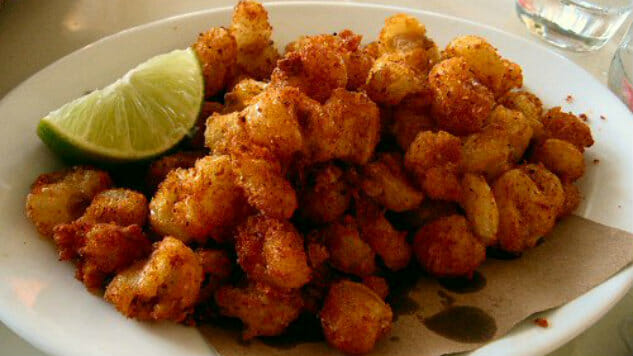
I had no idea what those white puffs were on my plate. My first thought: wet, soggy popcorn.
I didn’t wanna be rude; after all, they were nice enough to invite me to dinner. But I was wondering what kind of people eat whatever this was.
They said it was hominy. My next thought: What the heck is that?
“Oh, it’s good … try it,” they said. I decided to be adventurous and popped two in my mouth. My next thought: gross! The texture surprised me; not only was it soggy, it was bland. It tasted like paper. The little round, white pieces were shiny and kind of chewy. And even a tad slimy.
“Just salt it,” they said, as they giggled. In my opinion, there wasn’t enough salt in the world to make it better. Even if added salt enhanced the flavor, it sure wouldn’t help the texture. The texture got me more than the taste. Even though I didn’t like it, lots of people do.
But I had yet to be introduced to all the yumminess it can do.
I know. My first impression doesn’t sound very appetizing. And now you wanna know more before you try it. As it turns out, it’s been around a long time. And you might be more familiar with it than you realize.
What Hominy Is and How It’s Made
Let me tell you what hominy is. Hominy is corn kernels that have been soaked in a special solution of lime water (early settlers used a lye solution). The chemical process causes the hull to loosen and the corn to swell and soften. This process actually has a name: nixtamalization.
Without this process, we wouldn’t have a soft dough called masa. Masa is what’s used to make those yummy corn tortillas you love so much. You can learn to make masa in this video. Without masa, we wouldn’t have lots of corn products that are so popular in many cultures.
Where Hominy Originated
Hominy is simply corn that’s been soaked. And corn’s been around a long time, but was most often called maize. Maize is another name for corn.
If you look up maize in Merriam-Webster, you’ll see it says it’s Indian corn. One of the reasons it’s called Indian corn is because Indians grew, harvested, and ate corn in Mexico many years before it was introduced to Europe, supposedly by Christopher Columbus.
Dictionary.com says that hominy was first recognized by Captain John Smith in 1629 when he referred to a food called “parched corn;” they note that it probably meant it was ground or pounded.
While no one seems to know the exact origination, we know that corn’s been a staple for a long time.
Hominy vs. Grits
Have you ever seen, or eaten, hominy grits? Grits are made from hominy. And many people believe they originated in the South.
Although that’s probably not true, the South has lots of wonderful restaurants serving up great hominy inspired dishes.
Famed Southern chef Sean Brock recommends Charleston’s Hominy Grill; they serve up hominy grits for breakfast and make a mean plate of shrimp and grits, too.
If you’re a grits fan, you’ll probably like hominy. Their texture differs, but the taste is similar. If you eat hominy the same way you eat grits, you might not notice much difference.
Where to Buy It
Canned hominy can be found in most grocery stores in the canned vegetable section. Yep, it’ll probably be near the corn. Hominy can be made from yellow or white corn, if you have a preference. Hominy also comes dried; just soak it to rehydrate it (like you do with dried beans). Tip: I like to soak beans overnight in the fridge (but wash and rinse them first).
How to Prepare It
I was introduced to hominy from a can. It was heated on the stovetop, with butter, salt and pepper added. That’s the easiest way to try it.
But if you want to get more adventurous, you can add it to your favorite soups and stews. Hominy absorbs flavors of whatever dish it’s in. You can add it to casseroles, stir-fries, and Mexican dishes, too. This yummy cheese hominy and olive casserole is a great introduction to hominy, if you dare.
Nutritional Content
And listen up, weight-watching aficionados. Hominy is a low-fat food that’s easy on the waistline. A one-cup serving has about 119 calories and 1.5 grams of fat. If you’re counting carbs, it has about 24 grams; but the good news is that it’s a good source of fiber (4.1 grams). Heck, if you’re shooting for 20 grams of fiber each day, that’s nearly a fourth of your daily goal.
The point? Try something new like hominy. It’s easy to find, easy to prepare, and easy on the waistline.
And when you’re chewing, just imagine the first time the early American Indians tried it, or what Christopher Columbus thought about it. Or Captain John Smith.
How many foods have that kind of history and longevity? Chew on that thought.
Kelli H. Clevenger writes from her North Carolina horse farm that she shares with her husband, crazy puppy and bossy cat. Southern born and bred, she enjoys cooking and eating all things Southern and still eats a traditional meal of black-eyed peas and greens on New Year’s Day. Her passions are writing, animals, fitness and food, not necessarily in that order.